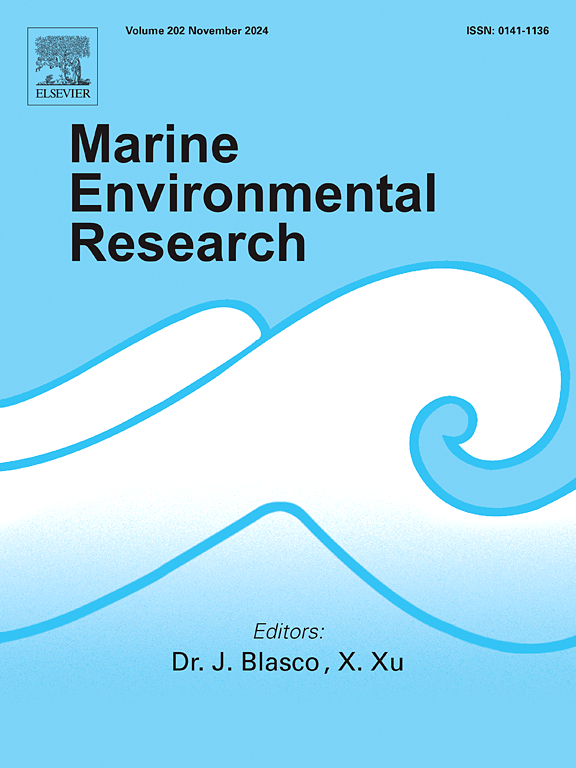Harpagifer bispinis, but not Patagonotothen tessellata, appears robust to interactive effects of ocean warming and acidification in southern Patagonia
IF 3
3区 环境科学与生态学
Q2 ENVIRONMENTAL SCIENCES
引用次数: 0
Abstract
Ocean warming and acidification challenge marine ectotherms with rapid, multiple and simultaneous environmental changes. As knowledge of these impacts on fish from the sub-Antarctic is scarce, this study seeks to explore the combined effects of warming and acidification on the thermal and metabolic responses of Patagonotothen tessellata and Harpagifer bispinis, two sympatric notothenioid fish from the Beagle Channel. Juveniles were exposed to present-day and near-future summer temperatures (∼10 and 13 °C) and pCO2 levels (∼500 and 1300 μatm) in a full factorial design. Their critical thermal minimum/maximum (CTmin/CTmax) were assessed and their partial thermal tolerance polygons were estimated. Oxygen consumption rates allowed us to calculate fish' aerobic scope (AS) as the difference between the standard and maximum metabolic rates (SMR and MMR). The CTmin of both species were affected by temperature, pCO2 level and their interaction, while the CTmax of P. tessellata was affected by both factors and that of H. bispinis, only by temperature. The partial thermal tolerance polygon of P. tessellata significantly decreased with future pCO2 levels, while no changes were observed for H. bispinis. In P. tessellata, SMR and MMR were affected by temperature and pCO2 levels and the AS by their interaction. Conversely, H. bispinis showed no differences in SMR, MMR and AS under different conditions. The increase in SMR and decrease in AS of P. tessellata with future temperatures and pCO2 levels may explain the changes in its thermal tolerance, while for H. bispinis, either the species has a greater capacity to adapt its metabolic response to warming and acidification, or different physiological processes are responsible for the observed changes in its thermal tolerance. Overall, present information could be a valuable tool for forecasting shifts in habitat suitability across the distribution range of both species and other similar fish in the context of climate change.

在巴塔哥尼亚南部,对海洋变暖和酸化的相互作用表现出很强的抵抗力,而对巴塔哥尼亚南部海洋变暖和酸化的相互作用表现出很强的抵抗力
海洋变暖和酸化以快速、多重和同步的环境变化挑战海洋变温动物。由于这些影响对亚南极鱼类的影响知之甚少,本研究旨在探索变暖和酸化对比格尔海峡(Beagle Channel)的两种同栖南极鱼类Patagonotothen tessellata和Harpagifer bispinis的热代谢反应的综合影响。在全因子设计中,将幼鱼暴露于当前和不久将来的夏季温度(~ 10和13°C)和二氧化碳浓度(~ 500和1300 μatm)。评估了它们的临界热最小值/最大值(CTmin/CTmax),估算了它们的局部热容多边形。耗氧量使我们能够计算鱼类的有氧范围(AS)作为标准代谢率和最大代谢率(SMR和MMR)之间的差异。两种植物的CTmin均受温度、co2浓度及其交互作用的影响,而扁叶杨的CTmax受这两种因素的影响,而双叶叶杨的CTmax仅受温度的影响。随着未来二氧化碳浓度的增加,白叶青树的部分热耐受多边形显著降低,而白叶青树的部分热耐受多边形没有变化。温度和co2浓度对青杨的SMR和MMR均有影响,而AS则受其相互作用的影响。相反,在不同条件下,比斯匹尼血吸虫的SMR、MMR和AS没有差异。随着未来温度和二氧化碳浓度的增加,小叶杨的SMR增加和AS减少可能解释了其热耐受性的变化,而对于双叶叶杨来说,要么是该物种对变暖和酸化的代谢反应有更大的适应能力,要么是不同的生理过程导致了其热耐受性的变化。总的来说,目前的信息可能是一个有价值的工具,用于预测在气候变化背景下两种鱼类和其他类似鱼类分布范围内栖息地适宜性的变化。
本文章由计算机程序翻译,如有差异,请以英文原文为准。
求助全文
约1分钟内获得全文
求助全文
来源期刊

Marine environmental research
环境科学-毒理学
CiteScore
5.90
自引率
3.00%
发文量
217
审稿时长
46 days
期刊介绍:
Marine Environmental Research publishes original research papers on chemical, physical, and biological interactions in the oceans and coastal waters. The journal serves as a forum for new information on biology, chemistry, and toxicology and syntheses that advance understanding of marine environmental processes.
Submission of multidisciplinary studies is encouraged. Studies that utilize experimental approaches to clarify the roles of anthropogenic and natural causes of changes in marine ecosystems are especially welcome, as are those studies that represent new developments of a theoretical or conceptual aspect of marine science. All papers published in this journal are reviewed by qualified peers prior to acceptance and publication. Examples of topics considered to be appropriate for the journal include, but are not limited to, the following:
– The extent, persistence, and consequences of change and the recovery from such change in natural marine systems
– The biochemical, physiological, and ecological consequences of contaminants to marine organisms and ecosystems
– The biogeochemistry of naturally occurring and anthropogenic substances
– Models that describe and predict the above processes
– Monitoring studies, to the extent that their results provide new information on functional processes
– Methodological papers describing improved quantitative techniques for the marine sciences.
 求助内容:
求助内容: 应助结果提醒方式:
应助结果提醒方式:


